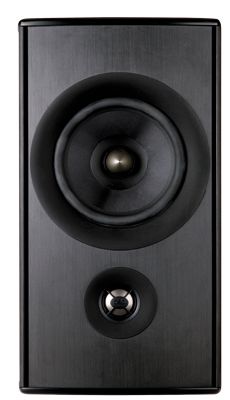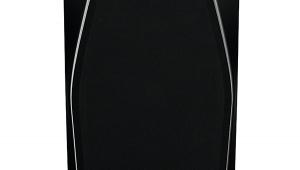Psb Synchrony Two B (£1200)

As the smallest and lightest speaker here, the Synchrony Two B may seem to be flying a kite in asking £1200 of its buyer. And, indeed, it is significantly cheaper in its native North America. But remember that its sibling, the large, floorstanding Synchrony One, won our group test in Aug ’09 – and take a look at the lab report. It may be diminutive but the Synchrony Two B walks tall: it has one of the flattest on-axis frequency responses here and a waterfall plot so clean that few more overtly prestigious speakers can match it.
Some of that cleanliness almost certainly derives from the Synchrony Two B’s cabinet, which in addition to having a small surface area is stiffened by means of curved side walls. Anodised aluminium extrusions mate the side panels to the front baffle and form the narrow rear panel, where the two pairs of input terminals are arranged vertically due to the lack of space. Beneath there’s a rear-firing reflex port that’s supplied with optional rubber closures to convert to closed-box bass loading.
Soft dome tweeters are in the majority in this test group but the Two B has a 25mm titanium dome with a neodymium magnet, ferrofluid in the magnet gap and a phase plug that doubles as a protective shield. Above it, a 165mm dual-layer glassfibre-coned bass-mid unit carries the rest of the frequency range.
DOWN THE PLUG
One issue to deal with, re Synchrony Two B’s sound quality, is the port plugs, which should be treated like a work of the devil. With them in place the PSB not only loses a chunk of bass extension, its sound becomes closed-in and muddled. Nowhere was this more obvious than when playing Scheherazade, which went from being spacious, crisp and alluring with the bungs removed to spatially flat and dynamically constipated with them inserted. My advice? Bin them.
That done, the PSB almost matches the ATC for tonal neutrality but delivers an expansiveness of imaging and delicacy of dynamics beyond the ATC’s ken. This breathed life and interest into both Scheherazade and the Kodály, encouraging prolonged listening.
There’s no escaping, though, that with its port open the Synchrony Two B lacks the tight bass control necessary to make tracks like ‘Come Together’ work successfully. If its bass line is fluffed this track loses its essential drive, and what should be ballsy becomes boomy. Otherwise it does a fine job of melding neutrality with openness, and of bringing a spark of interest to whatever it plays. ‘The Dog Song’, with its almost scary dynamic range, was a particular beneficiary.
Originally published in the October 2011 issue


























































